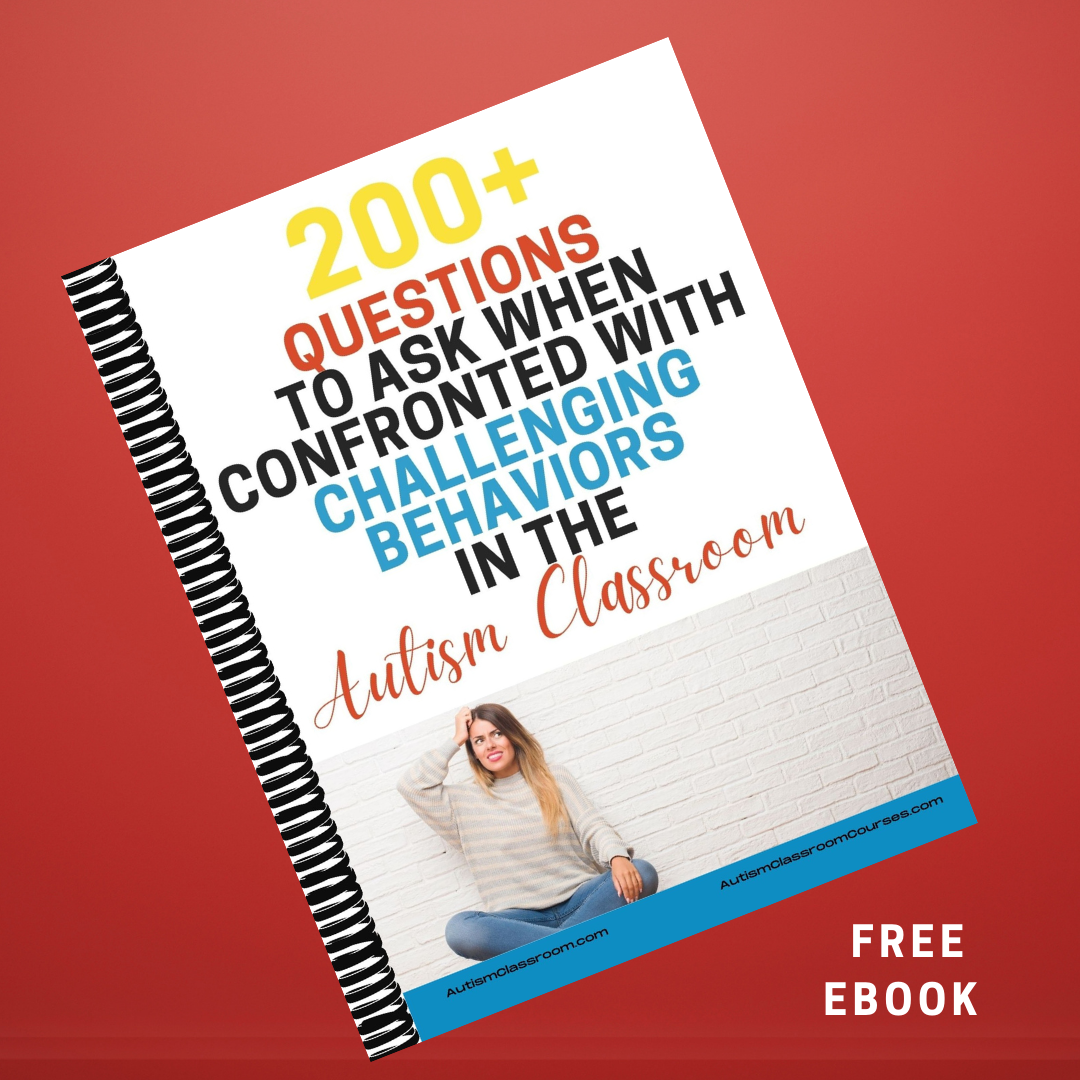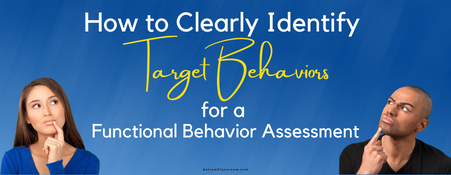Frustration. Tears. Shock. Stress. Certainly not words people use to describe their dream job-but when challenging behaviors enter the picture, sometimes these are the only words we can think of. For a little while…
But then, you add behavior supports or behavior interventions. Behavior supports are the strategies and plans you put in place ahead of time to help with experiences in the behavior you want to see. Behavior Interventions are items put in place to intervene and address what is going on.
You do not have to try them all at once, but you do want to know about them so that you can provide each student with a strategy that will be successful for them.
Behavior Support
Antecedent Based Interventions
Antecedent Based Interventions strive to change the environment ahead of time to avoid the behaviors in the first place. Other methods may attempt to provide a communication method that takes the place of the behavior's message and says the same thing without the individual using the challenging behavior.
Antecedent based interventions are rooted in a collection of evidence-based and proactive strategies that you can use to prevent problematic behavior before it arises. The solution often comes down to the way in which you can modify the classroom environment so that, hopefully, the behaviors do not occur. ABI’s are tools you can use to help set you and your learner up for success. You as a teacher can plan ahead of time to modify your classroom environment to ensure the success of every student. A few examples of ABI’s include using motivating items for task completion, using items of interest for task completion, and giving choices.
What could possibly trigger problematic behavior? Whether it be a certain object, or the way that things are arranged, the issue can be identified by your close observation skills. As soon as you’ve determined the source of the negative behavior, you can put the antecedent based intervention into action. Your students will soon begin to feel more in control of the space they’re learning in.
Reinforcing Visual Supports
Students on the autism spectrum often need more than one method of communication to fully comprehend a message. To reinforce the rules that you may convey by speaking alone, you can also add in visual support. These tools can help provide the clarity that might not get across to your students and can be as simple as a picture, graphic, or a word. Without any additional effort on your part, these visual supports can help students better understand what is expected of them when it comes to the routines, tasks, and rules of the classroom.
Stick to a Schedule
One big challenge that students on the autism spectrum often deal with is time management. It can be especially hard for them to know when to transition between activities or to adjust to sudden schedule change. To prevent any subsequent negative behavior from arising, it’s important to make sure that you establish a clear schedule which is consistently followed. Extra bonus points to you if you post a schedule as a visual support! This will help your students become more familiar with what is expected of them throughout the day.

Free Ebook from Autism Classroom Courses
Teaching Routines
Within the classroom, students can often feel overwhelmed with the number of tasks they have to do, from putting their coats in the cubbies and preparing their supplies to eating at lunch and solving difficult problems. If students don’t receive enough guidance on these routine tasks, then the tasks can almost become triggers for problematic behaviors on their own. By providing your students with mini routines on these tasks, this can ultimately help reduce the stress that comes with completion. It can also even increase their independence and confidence levels!
Providing Choices
As an educator or a parent, you can’t forget about giving your students the freedom to choose from time to time. It not only conveys that you respect the decisions they make, but also helps gain more confidence and control of their lives. It’s this very act of choosing for themselves that can aid in preventing problematic behaviors.
Visuals Schedules
Visual schedules are a wonderful way to bring your classroom routine to life. Students on the autism spectrum thrive with routine and giving them a visual on how the day will progress will help them feel more comfortable with the predictability of the day. These can be made with familiar pictures you’ve created from around your room or school, icons, or can even be student created with student chosen pictures, so they even have ownership in things in the classroom! Some students benefit from personal visual schedules that match the classroom schedule that they can manipulate once a task or class session has been completed.
Room Arrangement and Furniture Placement
This is essential for any classroom in special education. Having a classroom that is open can be too inviting for behaviors. Using natural boundaries can make things easier to process. Being in an environment with limited stimuli also helps in the area of focus and motivation as well! Flexible seating options in special education classrooms can really add an extra element of comfort and personal management control for students.
Planning
Planning engaging lessons ahead of time is essential for classrooms teaching students on the autism spectrum. Students with autism are not able to "go with the flow" so to speak most of the of the time. You will need to having structure and predictability in the school day to help them be successful with the material you are presenting and working on!
Informed Change of Plans
Changing of plans in your day is inevitable. It always happens at the most inopportune times! Informing students of the change, when it will occur, and reminding students of the change 2-3 times before the change, will help the student’s transition through the change of plans. You will be providing them with more success than if they were not informed of the change ahead of time.
Choices
Every student enjoys having a choice when it comes to the tasks they complete while at school. Giving students on the autism spectrum choices between two activities will help aid in task completion. While the choices being presented may not be a desired task, you can always follow it up with a First/Then statement: “First, complete one task, then, you may have your preferred task.”
Being Aware of Physiological Needs
As teachers, we must be aware of the medical needs of our students before planning activities that might trigger a behavior. For example, if a student is sent into a violent behavioral episode by the sounds of crying babies, you would not include the sounds of crying babies in the video you show to the class to review family dining etiquette in a restaurant.
 Behavior Intervention
Behavior Intervention
Interventions for students with autism are also essential in the classroom to ensure that each student is successful every day and can reach their full potential. Here are some interventions that can be used in a classroom with students with autism, or in any special education classroom setting.
Invest in token boards
Once a problematic behavior has arisen, you can invest in a token board as a visual way for a student to demonstrate their progress. These boards can encourage students to complete their tasks with a reinforcing reward at the end. Every time the student finishes a target task or behavior, you can hand them a token to place on a token board. As soon as the board is filled out, you can give them the reward and start the board over again.
Create social narratives
Social narratives are basically short stories you can create that allow students to gain a better understanding of the appropriate social behaviors to use in certain social situations. This helps your students develop more contextual skills in social settings because they are more explicit ways of learning.
As you’re crafting a story, be sure to focus on the key details at hand. Don’t forget to include a brief description of the situation, what the appropriate behavior should be, an explanation of why it’s appropriate, and how the behavior would benefit the student. In no time, your students will be able to apply those social narratives to the situations they counter in real life and choose the appropriate behaviors every time.
Clarify the Actual Issue
Behavior Support is most likely one of the main types of support educators, parents and family members are researching when they have an individual that has challenging behaviors. Behavior Support is complicated and should be highly individualized to the needs of the individual.
Many times you will need to begin identifying the target behavior (we have a very detailed article to get you in the right direction here) or you can click the image below.

Also, you need to then identify the root cause or function of the behavior behavior in order to develop a meaningful way to intervene.
Choice Making
Giving students a choice in the tasks they complete is a way you can build rapport with your students and help them build confidence within themselves in your classroom. To utilize this strategy, give students the choice between 2 tasks to complete, followed by a preferred task of the student for positive reinforcement.
Differential Reinforcement of Other Behaviors
This is an intervention where a teacher ignores the problem behavior and reinforces the student with a type of reward for any replacement behavior during a time frame. For example, teachers can ignore the behavior of a student who puts his feet up on a table or desk while sitting in a chair but reinforces the behavior of the student working on the given task for the class during independent work time with their feet on the floor. The student is receiving praise for appropriate behaviors in the classroom and not for the inappropriate ones.
Differential Reinforcement of Alternative Behaviors
This is an intervention that special education teachers can use to ignore inappropriate behaviors from students while immediately reinforcing an alternative behavior. For example, when a student is crying or yelling for item, the teacher ignores the cries and prompts the student to use their verbal skills or communication board to ask for the item they would like. Once the student does this, the student is met with immediate praise for using their communication skills to obtain the item.
Here are Various Pages that Discuss Behavior Interventions:


